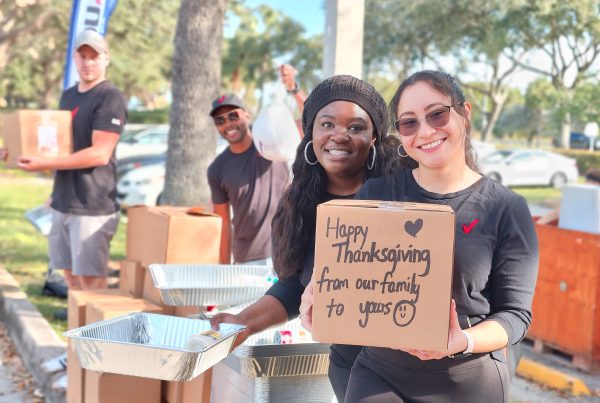Gluten has become a buzzy word, but what exactly is it? We sat down with Amy Levine Cohen, a veteran functional nutrition expert and gluten-free foodie who works with individuals and families interested in giving up gluten for good.
After moving from New York City to Boca Raton during the pandemic, Cohen, who has been gluten-free for more than 15 years, was inspired by our local restaurants’ standout gluten-free menus. She wanted to create a resource to give gluten-free families a stress-free dine-out experience, so she teamed up with the Gluten Intolerance Group (GIG), a national nonprofit working to “make life easier for everyone living gluten-free” through support groups, education, food safety research and its certification program. Cohen helped revitalize its 2008 Chef to Plate program with stricter standards. The first of its kind run by a national nonprofit, the gluten-free locator connects diners with restaurants, food trucks and bakeries serving gluten-free options. The program is launching nationally this year after a pilot in Boca Raton and Delray Beach.
“I wanted to help those in the community who want or need to be gluten-free,” Cohen says. “Everyone deserves to have delicious food, enjoy every bite and not have to do the dishes.”
What is gluten? It’s a protein in certain grains. It is often used to bind ingredients together to keep a certain shape or provide elasticity or stretchiness, as it does for dough.
Common gluten intolerance symptoms: Bloating, nausea, diarrhea, fatigue, joint pain.
Gluten intolerance vs. celiac disease; what’s the difference? Celiac disease is an autoimmune condition triggered by gluten. If your bloodwork comes back negative for celiac, you can be diagnosed with non-celiac gluten sensitivity. Pro tip: Before getting any bloodwork done, your diet must include gluten so that your immune system’s antibodies can be tested.
Where does gluten exist in food? Mainly in wheat, barley, rye, spelt, triticale, farro, malt and brewer’s yeast.
Where it gets tricky: Sometimes gluten can be hidden in “natural flavors.” Other times, ingredients like maltodextrin, an additive and sweetener, can be made of wheat unless derived from corn, potato or rice. Other household items may also include gluten, like shampoo and laundry detergent.
What is “gluten-free” on packaging? Since 2014, the FDA has required that the presence of gluten be less than 20 parts per million. It must not include any ingredient that has any wheat, rye, barley or crossbreeds of these grains and any ingredient derived from them that has not been processed to remove gluten.
Shopping tips: Read ingredient labels and check for third-party certifications, such as the Gluten-Free Certification Organization (GFCO), which uses a rigorous 80-point standard to ensure safe gluten-free products.
Benefits: Eating whole foods may include improved digestion, reduced inflammation, improved energy and clearer skin. Work with your doctor or nutritionist to ensure you get all your essential nutrients, and learn what supplements to take if necessary.
Tips on going gluten-free: If one person is gluten-free—especially a child—it’s helpful for the whole immediate family to be gluten-free. Being in it together and supporting one another is a game changer. Start with an elimination diet to see if your symptoms improve. Eliminate gluten for three to six weeks; two months or longer is ideal. If you want to hack your health, also eliminate corn, rice, soy, quinoa and buckwheat, as they can molecularly mimic gluten. Keep a journal to track how you feel. Then, slowly reintroduce one at a time.
What criteria must restaurants meet for Chef to Plate? They must meet the following criteria: Have plans implemented for safe production, service and display practices for gluten-free options; have an established method for verifying the gluten-free status of ingredients and menu options; provide a dedicated space and equipment (where necessary) to prevent cross-contact with gluten; use proper identification for gluten-free options, avoiding terms like “gluten-friendly” or “celiac safe”; handle all gluten-free orders with the same level of care, without asking questions like “is this a preference or an allergy?”; ensure there is a way for guests to identify that their meal is gluten-free easily.
Eating out tips: Find restaurants that clearly label their menus. If you order fried food, ask if the fryer is dedicated to gluten-free foods only. Note if the server is proactive about asking about allergies or intolerances—they should guide you to what’s safe for you to enjoy. Pro tip: Sushi rice may be made with rice vinegar that contains gluten. Ask for gluten-free rice or opt for sashimi. Soy sauce has wheat, so request gluten-free tamari.
Favorite local restaurants with stellar gluten-free menus? Burtons Grill & Bar, Garden Butcher, Vale Food Co, Wild Celery and Joey’s Home Bakery-Gluten Free. Visit the Chef to Plate site for a full list: gluten.org/ctp-participating-locations. Follow Amy @givingupglutenforgood and learn more at givingupglutenforgood.com.
While this story provides information and tips, you should always speak with your doctor first.
Hungry for more food news? Visit our food page, and subscribe to the magazine for the most delicious coverage of Boca and beyond.







